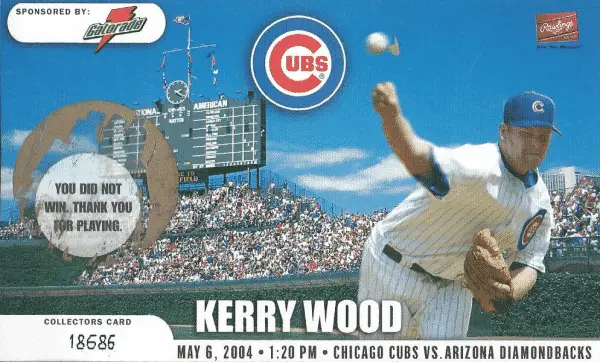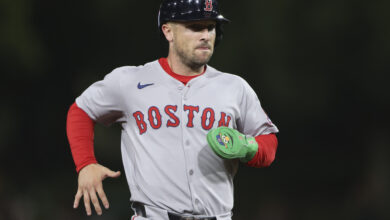
We Saw How the Cubs Dealt with Breakout Success and Lofty Expectations in 2004, but I’m Not Worried About 2016
September 25, 2004. Up 3-0 on the Mets, with two outs in the bottom of the ninth at Shea Stadium, LaTroy Hawkins gave up a three-run homer to Victor Diaz that sent the game into extras. The Cubs lost in the 12th when Craig Brazell hit a walk-off homer, the only round-tripper of his career. The Cubs came into that game at 87-66 and leading the Wild Card. But that defeat began a stretch of seven losses in eight games against the Mets, Reds, and Braves, the former two well out of contention and the latter having already wrapped up a playoff spot. Meanwhile, the Astros passed the Cubs in the final week to win the Wild Card.
The 2003 season ended in devastating fashion, but there was still a great deal of optimism going into 2004. The Cubs were returning several young star players and would have Aramis Ramirez and Corey Patterson for a full season. Plus they added Derrek Lee, Michael Barrett, Todd Walker, Greg Maddux, LaTroy Hawkins, and Kent Mercker to an already solid roster. On top of all that, they added Nomar Garciaparra at the trade deadline.
It was frustrating to watch a team with so much potential choke at the end of the season. I’ve been reminded a lot of that 2004 team this winters, as the Cubs are again an up-and-coming team making key veteran additions. Yet, I’m confident in my belief that the 2016 Cubs won’t suffer a fate similar to that of their predecessors. Here are four things that doomed the Cubs and 2004 and why things will, I hope, be different this time:
Kerry Wood and Mark Prior
Both missed significant time due to injury and saw their ERAs go up from 2003. Glendon Rusch filled in admirably when they were out, while Carlos Zambrano and Matt Clement had solid seasons, but the team should have been able to get more than 14 combined wins out of Wood and Prior. A big reason why the Cubs never even made it back to the NLCS under Jim Hendry was that the once-promising careers of these two pitchers were derailed by injuries. The team eventually had to convert Wood to a reliever, while Prior last pitched in the majors in 2006.
Why it won’t happen this time: Theo Epstein has taken a decidedly different approach from the one Hendry employed in building the rosters of those early 2000’s teams. Hendry tried to develop young pitching and add veterans like Moises Alou and Derrek Lee to the everyday lineup. It sometimes works — see what the Mets are currently doing — but it’s risky since young arms often burn out.
Epstein went the safer route and developed young position players while bringing in established major league arms for the rotation. For all the talk of the Cubs’ youth, their top four projected starters (Jake Arrieta, Jon Lester, John Lackey, and Jason Hammel) will all be at least 30 on Opening Day and all were developed by other organizations. Obviously, we can’t predict injuries. But I’m more confident having veterans with a solid track record in the rotation than having unpredictable young arms.
I also think, from an emotional standpoint, it’s better to have as much experience as possible in favor of the guys taking the bump. When your team is on defense, the pitcher is the center of attention. If a call from an umpire goes against you, or there are tempers flaring between the two dugouts, it’s good to have someone on the mound who can keep their cool and be an example to the defenders behind him.
Performance in close games
In 2004, the Cubs were 19-30 in one-run contests. Based on their Pythagorean W-L record, which measures how the team should have finished based on run differential, the Cubs should have won five more games. During that 1-7 stretch that cost them the Wild Card, five of the losses were by one run and three were in extra innings. Joe Borowski followed up his magical 2003 season with a miserable 2004, and LaTroy Hawkins eventually replaced him as closer. Hawkins had a solid season on the whole, but during this late-season stretch he blew two ninth inning leads and became a lightning rod for Cubs’ fans anger.
Why it won’t happen this time: In 2015, the Cubs went 34-21 in one-run contests. They also were 13-5 in extras (the 2004 squad went 12-11). Because of this, the Cubs outperformed their Pythagorean W-L record by seven games. Performance in close games is volatile, and it’s hard to say whether they’ll be able to even match their 2015 performance next year, but there’s reason to be optimistic just the same.
Clutch hitting and bullpen performance, while not the only factors in determining close games, are at least two of the biggest determiners. While the 2004 offense was built around veterans at the peaks of their careers, this new iteration has mostly young hitters who project to improve. In 2015, the Cubs batted .236 with runners in scoring position, third-worst in the majors, while their .211 mark with RISP and two outs was 24th of the 30 MLB teams. There figures to be nowhere to go but up. Plus, at least on paper, the Cubs appear to have a deeper bullpen than that ancestral team did.
This group of Cubs hitters also appear to be able to better handle high-pressure situations. According to BaseballReference.com, the 2004 Cubs batted .272 in low leverage situations, .269 in medium leverage, and .257 in high leverage. The 2015 Cubs hitters trended in the opposite direction: .235 in low leverage, .244 in medium leverage, and .263 in high leverage situations.
Uptight players
I still believe a big reason why the Cubs fell apart after the Bartman Play in 2003 was their inability to regroup afterwards. Moises Alou threw a tantrum. Mark Prior lost his focus. Everything was going right before that play and everything went wrong afterwards. It was not a coincidence.
But that was only the beginning. We witnessed several meltdowns from Cubs players in 2004. For example:
- July 19: The Cardinals, already running away with the division, were at Wrigley Field. After Carlos Zambrano hit the Cardinals’ Jim Edmonds with a pitch in the first, Edmonds homered off Zambrano in the fourth. Zambrano jawed at Edmonds while he was rounding the bases, upset that Edmonds stood at home plate too long admiring his home run. After giving up a go-ahead homer to Scott Rolen in the eighth, Zambrano plunked Edmonds again and was ejected.
- August 26-29: The Cubs and Astros met at Wrigley for a four-game series with Houston trailing the Cubs by six games in the Wild Card standings. The Cubs won the first game and were probably one more win from putting the Astros away. But in game two, when Houston pitcher Roy Oswalt came to bat in the second, Michael Barrett started jawing at Oswalt after getting hit by a pitch from Oswalt five days earlier. I’ll never forget the image of the Cubs catcher yelling at Oswalt while the much smaller, much less padded player just grinned, clearly amused. The Astros were the team on the ropes, yet the Cubs looked like the ones wilting under pressure. Meanwhile, Kerry Wood gave up four home runs as the Astros won, 15-7. Houston also won the final two games of the series to begin a 28-7 run to close out the season.
- Then there was the feud with the announcers. Kent Mercker, who the Cubs brought in to be a veteran presence in the bullpen, called the broadcast booth during a game to complain about comments from Chip Caray and Steve Stone and supposedly confronted them on at least one other occasion.
Why it won’t happen this time: Dusty Baker came to Chicago with a great reputation, but he didn’t appear to have control over his team. I have much more faith in Joe Maddon and this current group of players. And it was nice to see the Cubs on the other side of a team losing their cool in a couple instances late in this past season, particularly in the Wild Card game against the Pirates. This gives me confidence that they can keep their cool when things get tense.
Sammy Sosa
On a team full of hotheads, Sosa gets his own mention. Fans at Wrigley adored Sosa for years, but he started to wear out his welcome in 2003. First, he was caught using a corked bat in a game against Tampa Bay. The next year, the wisecracks continued when he hurt his back sneezing. But he alienated fans once and for all when he left on the final day of the season before the game was over.
It didn’t help matters that Sosa, who was again supposed to be a veteran presence and a key contributor on offense, suffered through his worst statistical season in ten years. His antics clearly were a distraction for a team that didn’t need any more. The Cubs traded him to Baltimore the following offseason.
Why it won’t happen this time: There are no larger-than-life characters on this roster (unless you count Joe Maddon, but I mean that in the best way possible). Sosa was around for many losing years and was used to being the main attraction at Wrigley Field. When he was clubbing tons of home runs and the team wasn’t in contention, fans found his flamboyant show of emotion charming. When the team started winning and his numbers started to decline, he became a distraction.
The closest parallel I can think of with the current edition of the Cubs is Starlin Castro, though it wasn’t on nearly as grand a scale. While Sosa seemed unable to handle the transition to a winning ballclub, Castro embraced it, actually taking his demotion during this past season well. Castro is gone now, but I think his attitude last year is representative of the more positive, team-oriented clubhouse Maddon is leading.
Cubs fans have every reason to be optimistic. It’s what true fans do. But we don’t need to be acting like we’re entitled to anything in 2016 either, even though, on paper, the Cubs have what many believe to be the strongest roster in baseball. I’m going to enjoy the season from start to finish and hold onto the same hope I have every season: that this will be “the year.”

